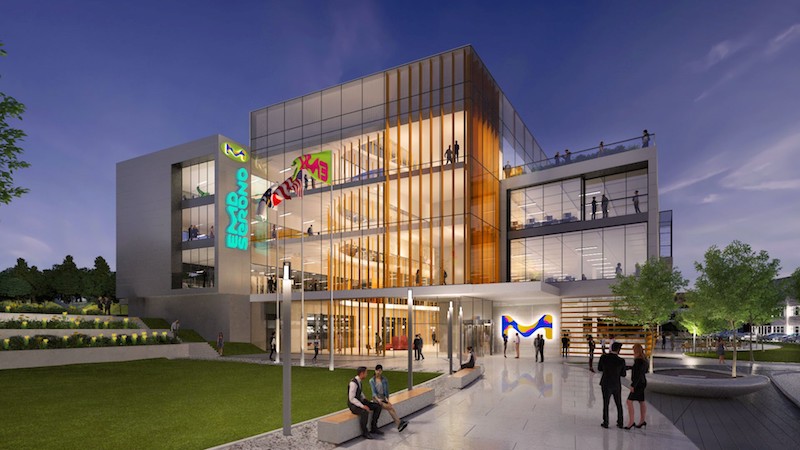EMD Serono, an affiliate of Merck KGaA, the Darmstadt, Germany-based healthcare and life sciences company, is investing another $70 million to double the size of its research and development facility in Billerica, Mass., which opened in February 2011.
The 145,000-sf expansion on 47 acres is expected to break ground in the second quarter of this year, and be completed by the second quarter of 2021. The new building will accommodate 400 new and current R&D employees who will focus on advancing science in oncology, immuno-oncology, and immunology.
Billerica’s Planning Board approved the expansion, without protest, on February 12, when it also okayed a waiver of a formal traffic study as long as the company provides a traffic memorandum for peer review. Merck KGaA’s investment includes about $55 million in construction costs, and several million dollars for laboratories and equipment.
With this latest project, Merck KGaA will have invested more than $150 million in infrastructure and construction in the state of Massachusetts, and created more than 150 new jobs. That investment “is a testament to the state’s global leadership in life sciences,” says Travis McCready, President and CEO of the Massachusetts Life Sciences Center.
When it’s completed, the new building will include wet labs, office space, and a cafeteria. It will be built to meet LEED and WELL performance standards. (The existing facility is WELL certified.) The Building Team on this project includes PM Group (architect), INTEC (interior design), Erland Construction (CM), BR+A Consulting Engineers (mechanical and electrical engineer), and BSC Group (CE).
Billerica is one of 10 locations in Massachusetts where Merck KGaA employs more than 2,800 people. Billerica is also one of Merck KGaA’s four global R&D hubs, the others being in Germany, Japan, and China. Merck KGaA invests about 20% of its total annual sales in R&D.
Related Stories
| Jul 18, 2014
2014 Giants 300 Report
Building Design+Construction magazine's annual ranking the nation's largest architecture, engineering, and construction firms in the U.S.
| Jul 7, 2014
7 emerging design trends in brick buildings
From wild architectural shapes to unique color blends and pattern arrangements, these projects demonstrate the design possibilities of brick.
| Jul 2, 2014
Emerging trends in commercial flooring
Rectangular tiles, digital graphic applications, the resurgence of terrazzo, and product transparency headline today’s commercial flooring trends.
| Jun 18, 2014
Arup uses 3D printing to fabricate one-of-a-kind structural steel components
The firm's research shows that 3D printing has the potential to reduce costs, cut waste, and slash the carbon footprint of the construction sector.
| Jun 12, 2014
Austrian university develops 'inflatable' concrete dome method
Constructing a concrete dome is a costly process, but this may change soon. A team from the Vienna University of Technology has developed a method that allows concrete domes to form with the use of air and steel cables instead of expensive, timber supporting structures.
| Jun 9, 2014
Green Building Initiative launches Green Globes for Sustainable Interiors program
The new program focuses exclusively on the sustainable design and construction of interior spaces in nonresidential buildings and can be pursued by both building owners and individual lessees of commercial spaces.
| May 29, 2014
7 cost-effective ways to make U.S. infrastructure more resilient
Moving critical elements to higher ground and designing for longer lifespans are just some of the ways cities and governments can make infrastructure more resilient to natural disasters and climate change, writes Richard Cavallaro, President of Skanska USA Civil.
| May 20, 2014
Kinetic Architecture: New book explores innovations in active façades
The book, co-authored by Arup's Russell Fortmeyer, illustrates the various ways architects, consultants, and engineers approach energy and comfort by manipulating air, water, and light through the layers of passive and active building envelope systems.
| May 19, 2014
What can architects learn from nature’s 3.8 billion years of experience?
In a new report, HOK and Biomimicry 3.8 partnered to study how lessons from the temperate broadleaf forest biome, which houses many of the world’s largest population centers, can inform the design of the built environment.
| May 13, 2014
19 industry groups team to promote resilient planning and building materials
The industry associations, with more than 700,000 members generating almost $1 trillion in GDP, have issued a joint statement on resilience, pushing design and building solutions for disaster mitigation.
















